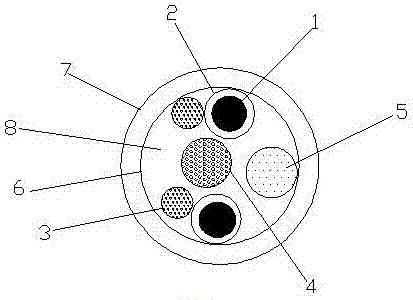Waterproof electric vehicle charging cable and fabrication method thereof
A technology for charging cables and electric vehicles, which can be applied to power cables including electronic control, power cables, and power cables including electrical communication lines, etc., and can solve problems such as battery life limitations.
- Summary
- Abstract
- Description
- Claims
- Application Information
AI Technical Summary
Problems solved by technology
Method used
Image
Examples
preparation example 1
[0034] Polypropylene resin (weight-average molecular weight: 10,000), polyethylene resin (weight-average molecular weight: 20,000), ethylene-vinyl acetate copolymer (weight-average molecular weight: 5,000), isodecyl phthalate, nano-titanium oxide , calcium silicate, kaolin, grade KH-550 silicone coupling agent, glycerol, dibutyl phthalate and silicon dioxide are mixed, then melted at 250°C for 60mim, and finally extruded at 185°C Molding is to make described outer sheath, and thickness is 3mm and is denoted as W1;
[0035] Among them, polypropylene resin, polyethylene resin, ethylene-vinyl acetate copolymer, isodecyl phthalate, nano-titanium oxide, calcium silicate, kaolin, grade KH-550 silicone coupling agent, glycerol , The weight ratio of dibutyl phthalate to silicon dioxide is 100:20:2:1:3:1:2:2-6:1:1:1.
preparation example 2
[0037] Polypropylene resin (weight-average molecular weight: 15,000), polyethylene resin (weight-average molecular weight: 25,000), ethylene-vinyl acetate copolymer (weight-average molecular weight: 8,000), isodecyl phthalate, nano-titanium oxide , calcium silicate, kaolin, grade KH-550 silicone coupling agent, glycerol, dibutyl phthalate and silicon dioxide are mixed, then melted at 265°C for 55mim, and finally extruded at 190°C Molding to make the outer sheath, the thickness is 4mm, denoted as W2;
[0038]Among them, polypropylene resin, polyethylene resin, ethylene-vinyl acetate copolymer, isodecyl phthalate, nano-titanium oxide, calcium silicate, kaolin, grade KH-550 silicone coupling agent, glycerol , The weight ratio of dibutyl phthalate to silicon dioxide is 100:30:5:2:5:3:3:4:2:3:1.
preparation example 3
[0040] Polypropylene resin (weight-average molecular weight: 20,000), polyethylene resin (weight-average molecular weight: 30,000), ethylene-vinyl acetate copolymer (weight-average molecular weight: 10,000), isodecyl phthalate, nano-titanium oxide , calcium silicate, kaolin, grade KH-550 silicone coupling agent, glycerol, dibutyl phthalate and silicon dioxide are mixed, then melted at 280°C for 60mim, and finally extruded at 200°C Forming to make the outer sheath, the thickness of the outer sheath 7 is 5mm, denoted as W3;
[0041] Among them, polypropylene resin, polyethylene resin, ethylene-vinyl acetate copolymer, isodecyl phthalate, nano-titanium oxide, calcium silicate, kaolin, grade KH-550 silicone coupling agent, glycerol , The weight ratio of dibutyl phthalate to silicon dioxide is 100:40:10:3:8:5:5:6:3:4:2.
PUM
| Property | Measurement | Unit |
|---|---|---|
| Diameter | aaaaa | aaaaa |
| Thickness | aaaaa | aaaaa |
| Pitch | aaaaa | aaaaa |
Abstract
Description
Claims
Application Information
 Login to View More
Login to View More - R&D
- Intellectual Property
- Life Sciences
- Materials
- Tech Scout
- Unparalleled Data Quality
- Higher Quality Content
- 60% Fewer Hallucinations
Browse by: Latest US Patents, China's latest patents, Technical Efficacy Thesaurus, Application Domain, Technology Topic, Popular Technical Reports.
© 2025 PatSnap. All rights reserved.Legal|Privacy policy|Modern Slavery Act Transparency Statement|Sitemap|About US| Contact US: help@patsnap.com


